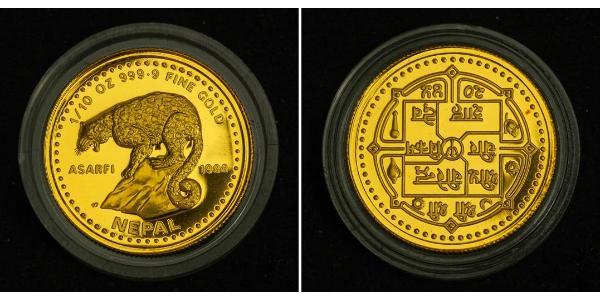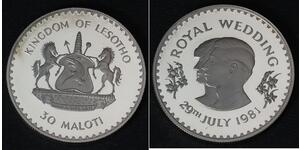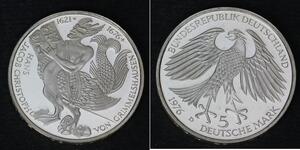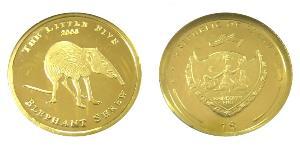(售价 $269.0)
1988, Nepal. "Snow Leopard" Proof Gold 1/10 Oz Asarfi Coin. Only 2000 Struck!
Mint Year: 1988
Condition: Proof!
Mintage: 2,000 pcs.
Denomination: Gold 1/10 Asarfi - Snow Leopard
Weight: 3.11gm (1/10 Oz)
Material: Gold (.999)
Diameter: 17mm
The snow leopard (Panthera uncia syn. Uncia uncia) is a large cat native to the mountain ranges of Central and South Asia. It is listed as endangered on the IUCN Red List of Threatened Species because as of 2003, the size of the global population was estimated at 4,080-6,590 adults, of which fewer than 2,500 individuals may reproduce in the wild. Snow leopards inhabit alpine and subalpine zones at elevations from 3,000 to 4,500 m (9,800 to 14,800 ft). In the northern range countries, they also occur at lower elevations. Taxonomically, the snow leopard was classified as Uncia uncia since the early 1930s. Based on genotyping studies, the cat is considered a member of the genus Panthera since 2008. Two subspecies have been attributed, but genetic differences between the two have not been settled.
Birendra Bir Bikram Shah Dev (वीरेन्द्र वीर विक्रम शाह) (28 December 1945 – 1 June 2001) was the 11th King of Nepal and a South Asian statesman. The eldest son of King Mahendra, whom he succeeded in 1972, he reigned until his death in the 2001 Nepalese royal massacre. He is the most internationally well-known Nepalese king in modern history.
From a very young age, Birendra was described even by his school teachers as a very kind and emotional prince. King Birendra was described as one of the few Nepalese monarchs who wanted the Nepalese people to experience real democracy. This was observed in the 1980 Janmat Sangraha (2038 B.S. Referendum) when he wanted the people to choose whether they wanted 'multiparty democracy' or a 'reformed Panchayat system'. Also, in People's Movement I, he decided to establish 'Constitutional Monarchy' in Nepal instead of fighting for dictatorship.
In 1989, when the People’s Movement I was taking momentum, at the condition of safeguarding the panchayat system, Indians had put forward some conditions to King Birendra aimed at taking control over our national sovereignty. If the King had accepted these conditions, the panchayat system would not have ended. But the king said that, "It is better to surrender to the people rather than surrender to India.”
Some historians would speculate that Late King Birendra's democratic views and simple nature lead to the success of the People's Movement I (1990). He is credited for introducing (envisioning) SAARC in Asia in order to strengthen the foreign relations of Nepal with the South Asian countries.
King Birendra was born at the Narayanhity Royal Palace in Kathmandu as the eldest son of the then Crown Prince Mahendra Bir Bikram Shah Dev and his first wife Crown Princess Indra Rajya Laxmi.
King Birendra had spent eight years studying at St Joseph's College, a Jesuit school in Darjeeling. On 13 March 1955 his grandfather King Tribhuvan died and his father succeeded to the Nepalese throne. With his father's ascension King Birendra became the Crown Prince of Nepal.
In 1959 King Birendra enrolled at Eton College in the United Kingdom. After studying at Eton until 1964 he returned to Nepal where he began to explore the country by travelling by foot to the remote parts of the country where he lived on whatever was available in the villages and monasteries. He later completed his education by spending some time at the University of Tokyo before studying political theory at the Harvard University from 1967 to 1968. Late King Birendra enjoyed to travel in his youth and went on trips to Canada, Latin America, Africa and a number of Asian countries. He was also an art collector and supporter of Nepalese crafts people and artists. He also learnt to fly helicopters.
King Birendra was married to Aishwarya Rajya Laxmi Devi Rana from the Rana family on 27 February 1970. The wedding which was billed as one of the most lavish Hindu nuptial ceremonies in history cost $9.5 million to stage. King Birendra and Queen Aishwarya had three children.
Birendra succeeded the Nepalese throne on 31 January 1972 after the death of his father, King Mahendra. On his ascension he was effectively an absolute monarch as he inherited a country where political parties were banned and he ruled through a system of local and regional councils known as panchayats. Birendra resented the absolute monarch tag maintaining that he presided over a democracy in which representatives to the assembly were indirectly elected and saying that his poor and backward country could not afford a democracy based on party politics and that it needed firm and decisive government. His first trips abroad as king were to India in October 1973 and China two months later as he believed that Nepal, sandwiched between the two Asian powers, should have good relations with both.
In an attempt to maintain the panchayat system of government prominent leaders of the Nepali Congress Party were arrested. Because of the growing pro democracy movement Birendra announced that a referendum to decide between a non-party and a multi-party system would be held. The referendum was held in May 1980 with the non-party system winning by a margin of 55% to 45%. During the 1980s the restraints that had been imposed on political organisations were starting to ease and liberal student-led groups were starting to appear demanding constitutional change in Nepal. He was made a British Field Marshal in 1980.
In 1990 a series of strikes and pro-democracy riots broke out in Nepal. Because of the rioting Birendra agreed to become a constitutional monarch. He appointed an independent Constitution Recommendation Commission to represent the main opposition factions and to prepare a new constitution to accommodate their demands for political reform. The commission presented him with the draft of the proposed constitution on 10 September 1990. The new constitution would make Birendra head of state of a constitutional monarchy with a system of multiparty democracy. The draft constitution was approved by the Prime Minister Krishna Prasad Bhattarai and his cabinet and so on 9 November 1990 Birendra promulgated the new constitution transforming Nepal into a constitutional monarchy.
However, the quarrels between various political parties and numerous social problems led to the Nepalese Civil War, a conflict between Maoist rebels and government forces, which lasted from 1996 until 2006.
In 1975, on the occasion of the coronation ceremony, the King presented the proposal to recognise Nepal as a zone of peace with a view to promote new dimension to Nepal's non-alignment policy, and to accept peace as the most for the important progress of the nation. Nepal as a zone of peace was recognised by 116 countries of the world.






















